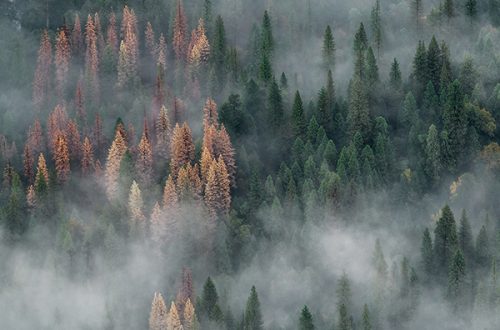Burn to Not Burn
by jonathan collyer
 As I write from a rudimentary “office,” having been evacuated from our home near the CZU Lightning Complex Fire, San Mateo and Santa Cruz counties have lost 80,000 acres of forest and some 500 hundred or so structures. Across the state, what is being called “the August Lightning Siege of 2020” has brought the years destruction to 1.4 million acres and the fire season is far from finished.(1)
As I write from a rudimentary “office,” having been evacuated from our home near the CZU Lightning Complex Fire, San Mateo and Santa Cruz counties have lost 80,000 acres of forest and some 500 hundred or so structures. Across the state, what is being called “the August Lightning Siege of 2020” has brought the years destruction to 1.4 million acres and the fire season is far from finished.(1)
2020 may break all previous records for acres burned, but those records were set in 2017, 2008 and 2018 respectively. All but three of the “top 20 largest California wildfires have occurred since 2000, with 10 of these large and damaging wildfires occurring in the last decade.”(2)
According to Cal FIRE’s 2019 Community Wildfire Prevention & Mitigation Report(3), “More than 25 million acres of California wildlands are classified as under very high or extreme fire threat.” At the annual burn rate we’ve seen in the past three years, we’ll probably lose most of those acres in the next decade. Besides the cost to our natural environment and lost lives, there’s an annual cost in destroyed homes, economic disruption and fire fighting expenses, which often mounts in the tens of billions. To plot a path out of the seasonal malaise, lets first ask “How did we get here?”
Forest fires are nothing new. Beginning around 360 million years ago (about 80 million years after plants first colonized the land), the planet Earth entered into the “Age of Fire”. The crucial ingredient was oxygen, the explosive molecule by which we create our aerobic energy and the main byproduct of photosynthesis. Once the plant matter on planet earth was sufficient to produce enough oxygen to support the spread of flame, large fires became a common occurrence, sparking a variety of adaptations and an increase in bio-diversity.(4)
Our prehistoric ancestors are thought to have acquired the use of fire as far back as 2 million years ago. Since the dawn of the Holocene (c. 11,650 years ago), the use of fire as a tool has had widespread and profound effects on our natural environment. From Australia to North America, anthropogenic fire has been used to shape our environment to meet the needs of the scope of human hunters, gatherers and cultivators.
At the time of first contact with a Spanish expedition in 1769, the native Quiroste people of Central California (living within contemporary Año Nuevo State Park) used frequent fires to manage their local environment “for a better yield of the grass seeds that they eat”. Under Quiroste stewardship, “the valley was full of meadows, hazel groves, and stretches of burned earth”.(5)
According to a report in Forest Ecology And Management, “Approximately 1.8 million ha (~4.4 million acres) burned annually in California prehistorically (pre 1800).”(6) So, prior to the arrival of Europeans, roughly four times as many acres theoretically burned in California per year from natural causes and indigenous land stewardship than during these two decades of apparent disaster.
The idea that our local environment lay feral and undisturbed by human hand until the industrial revolution and the population boom is comically false. Humans have been dramatically effecting our local environment for at least 10,000 years. The question isn’t whether we interfere with nature or not. Limiting human activity in natural spaces is itself a profound form of interference.
It wasn’t until after particularly destructive Idaho and Montana wildfires in 1910 that fighting fires became an accepted policy. Where indigenous peoples, like the Quiroste, used fire to maintain a ~100 year cycle between grassland, forest and fire, that cycle has been largely stopped to protect homes and infrastructure increasingly nestled in our wild lands.
In California, a quarter of our population, some 11 million people, live in fire prone areas.(7) Retreating from the natural environment to allow fires to burn is not a practical option. Controlled burns, often with guidance from indigenous peoples (8), are a cost effective mitigation strategy.
Currently, the state burns about 90,000 acres a year. Let’s make sure our state and local governments streamline the process of obtaining the necessary permits to burn on public lands, while developing the expertise required to safely conduct controlled burns.
Beyond controlled burns, a variety of mitigation strategies exist, including forestry and small wood and forest by-product economy development. In no scenario are we helpless, as long as we activate our best minds and are willing to act decisively, preferably prior to the summer of 2021.
- mercurynews.com/2020/08/24/california-nears-record-in-2020-for-acres-burned-and-its-not-even-september/
- twitter.com/CAL_FIRE/status/1298383464094265344/photo/1
- fire.ca.gov/media/5584/45-day-report-final.pdf
- forbes.com/sites/trevornace/2015/11/19/the-age-of-fire-when-ancient-forests-burned/#26ead7b45f02
- archaeology.org/issues/272-1709/letter-from/5826-letter-from-california-fires
- sciencedirect.com/science/article/abs/pii/S0378112707004379#aep-abstract-id7
- cnbc.com/2019/11/09/why-californias-wildfires-are-going-to-get-worse.html
- motherjones.com/environment/2019/11/californias-wildfire-controlled-prescribed-burns-native-americans/








5 Comments
Kevin Thompson
A very insightful and interesting piece. I have an anthropology background, and worked as a wild land fire fighter for the California Department of Forestry in the late 90’s. This is all very accurate and important information for us as Californians to know and understand. I appreciate the research done and informative message relayed by this article, well done.
Rich
Excellent article!
Renita Thomas
You rocked this subject and have astounding insights. I also work hard in putting together great content about Airport Transfer, feel free to visit QH8
Maxwell Perl
An interesting topic and I’m glad to come across your page where I found some helpful insights. Check out my website QU6 too, if you need additional resources about Thai-Massage.
VABxvsyH
1